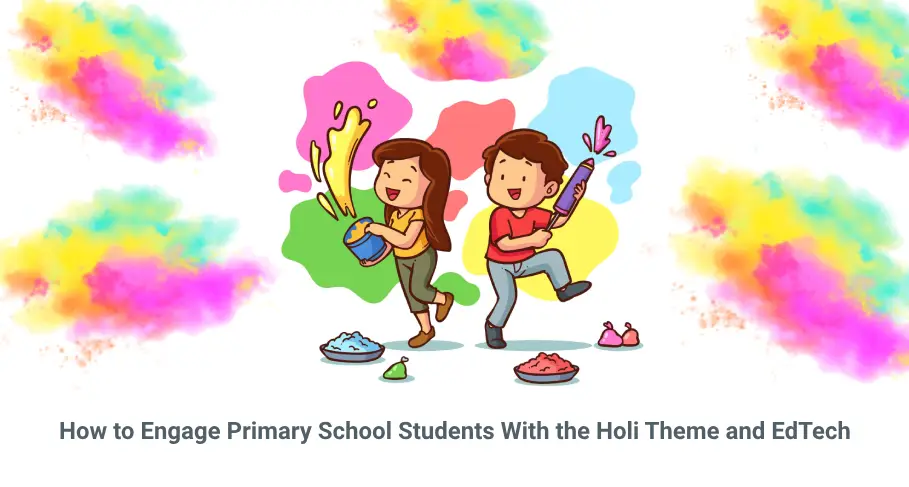As a teacher, it’s your responsibility to help students feel excited to come to school in the midst of Holi celebrations, whether they last for 2 days or 2 weeks. Among younger year groups, you have the ability to imprint some of your students’ first key memories of Holi. Many of us will remember craft classes for making decorations for The Festival Of Colours in our own childhood.
Now, with advanced technologies widening the horizons for early education, there are many more ways you can engage primary school students in learning about and celebrating Holi. In this article, we’ll provide you with some suggestions for turning your classroom into a space that inspires students to learn more about the history and cultural significance behind Holi and how they can enjoy it.
Here are our top tips on engaging primary school students in the classroom for Holi.
Create Holi Posters & Cards
Students love to get hands-on in tasks, so a DIY arts and crafts lesson is an interactive way to get practically involved in Holi rather than just sitting through lessons and hearing about it. You can make Holi posters and cards to display in your classroom and take home and to share with family members and fellow classmates… or even your favourite teacher!
Allow your students’ creativity to run wild with plenty of art materials for them to experiment with. You can also help improve their IT skills on easy-to-use sites like Adobe Express, where students can learn the digital arts of Photoshop, picture manipulation and graphic design. To create virtual art, you can email it to relatives further away or print it out to hang up in the classroom.
Holi Storytelling: Reading & Writing
The mythology behind the origins of Holi is an important part of its history that should be shared in the classroom. The festival celebrates the love between the Hindu gods Radha and Krishna through their playful experimentation with colour to symbolise their unity beyond social barriers.
It also marks the triumph of good over evil, celebrating the victory of Vishnu over the indestructible demon Hiranyakashipu. These stories are embedded in Indian Hindi culture, and their narratives are colourful enough to bring them to life through storytelling.
Once your students have learned the myths surrounding the origin of the Holi festival, why not encourage them to create or draw their own?
Develop their literacy skills and writing ability by having them delve into their imaginations to develop their own stories for the origin of Holi. You could then share these as a class, and foster an environment of supportive collaboration.
Tie Holi Into Your Science Lessons
Also known as The Festival of Colours, Holi is synonymous with bright dyes, paint balloons, and an eruption of colour across streets and people. While it may not be appropriate to send your students home with their uniforms stained, you can still harness the excitement in your lessons by focusing on the science behind colour.
Teach your students about the colour wheel, demonstrate how colours are made from existing ones, and how certain colours are created through some chemical reactions. Set up simple chemical experiments and visually stimulating colour-related scientific phenomena such as a prism of light.
Your students will be surrounded by colour outside the classroom during the Holi period, so embrace this external stimulus by giving them a deeper understanding of how we are able to perceive it in the first place.
Learn How Other Cultures Celebrate The Start Of Spring
India is not the only country that celebrates Holi, with Nepal and Indian diasporas across the world joining in the celebrations – such as Mauritius, The Caribbean and parts of Hindi Indonesia.
Even within India, different celebrations take place. For example, in Manipur, the festival is initiated with the burning of a thatched hut to symbolise the banishment of evil. In some families in Gujarat, there is a custom where a woman ‘beats’ her brother-in-law in mock rage with a sari while drenching him in colour while he placates her with traditional desserts in the evening.
Bring the rituals of Holi alive with these diverse stories, and explore the many ways Holi is celebrated across and beyond India. Then, look further afield at how other countries typically celebrate the start of Spring, from the spiritual Buddhist Songkran Water Festival in Thailand to the annual cheese rolling competition in Gloucester, England.
Show & Tell
A classic show-and-tell activity works wonders in a primary school classroom. It not only fosters group listening skills and public speaking but also helps students feel individually part of something bigger.
Most students will likely celebrate Holi with their families, so you can send a letter to parents asking their children to bring in an item or food that they traditionally associate with Holi, followed by a short explanation of their family rituals around this time.
It’s also important to teach cultural competence and diversity—one of the principles that Holi stands for. Students who do not celebrate Holi or are from a different ethnic background can bring something that represents their culture and speak about a tradition in their country or a family ritual they take part in at home. Showing children from a young age that there are so many differences across cultures and between individuals is a good way to foster positive social attitudes for the future.
Holi is an exciting opportunity to get your students engaged in group activities by sharing individual stories and working together to create bigger projects, such as making class decorations.
Sprinkle in a little colour across all your subjects, and you’ll be sure to witness the results in your students. We hope we’ve given you some inspiration on how to incorporate The Festival of Colours into your classroom. Happy Holi!
